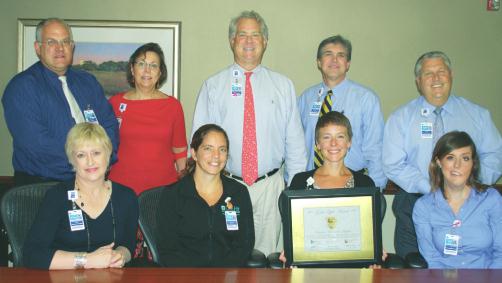Basic HTML Version


Doctor Referral Service: 888-522-5585
• Health Scene
13
Success tastes sweet!
BMH earns Gold Apple award
for healthy food choices
the South Carolina
Hospital Association (SCHA)
Working Well initiative recently recognized Beaufort
Memorial for achieving the highest standard of excel-
lence in healthy food environments for employees. Jen
Wright, the SCHA’s Working Well manager, presented the
hospital’s Working Well team with the Gold Apple award
on July 30.
“The hospital’s team, along with their nutrition service
partner, Sodexo, has done a wonderful job of develop-
ing policies and environments that make healthier
food choices more accessible and more affordable,” says
Wright.
Working Well, funded by the Duke Endowment and
managed by the SCHA, is an effort to improve the health
of hospital employees across the state by establishing a
worksite wellness culture in which the healthy choice is
the easy choice. The goal is to become a model for work-
site wellness in the community.
Beaufort Memorial’s Working Well team embraced the
SCHA’s commitment to workplace wellness as a model
for the community over a year ago, when they attended a
Working Well Boot Camp in Columbia. Since that time,
the team has addressed three areas of workplace well-
ness: tobacco use, healthy food and nutrition, and physi-
cal fitness.
Besides naming Beaufort Memorial a Center of
Excellence for workplace wellness, the SCHA has pre-
sented the hospital with the Gold Star award for elimi-
nating tobacco use on campus. The Gold Apple award is
the second of three goals set by the BMH team, and work
continues on the final goal of physical activity.
If you’re a fan
of Italian cuisine, whole-grain pasta can do a whole lot of
good for your health.
“Whole-grain pasta has more nutritional value than the more
traditional pastas,” says Roxanne Davis-Cote, MPH, RD, LD, Clinical
Nutrition Manager. “It helps with weight management and helps you
feel fuller for a longer period of time.”
The reason? The answer is in its name.
Whole grains are made up of three parts—bran, germ and endosperm.
When grain is refined, the bran and germ are removed. This is done to
give grains a finer texture and improved shelf life. But it also removes
dietary fiber, iron and many B vitamins.
“When eating regular pasta, you’re missing out on the nutrient-rich parts of
the grain—the germ and the bran,” Davis-Cote continues. “The bran is where
most of the fiber is found, and the germ is where the heart-healthy fats and
vitamins and minerals are located.”
Whole-grain pasta may taste a little different than other pastas, but, if
prepared properly, it can be just as delicious.
Whole-grain pasta takes a little longer to cook than refined pasta. But
you want to be careful to follow directions and not overcook it, or it may
become mushy.
Top off whole-grain pasta with olive oil, fresh garlic, grated cheese or a red sauce
with sautéed vegetables and you have a delicious and nutritious meal.
“Choosing whole-grain pasta is another excellent way to add more whole grains
into your diet, aiming for a goal of half of your daily grains coming from whole-
grain sources,” Davis-Cote concludes.
Eating whole grains
can help reduce
your risk of heart
disease and other
chronic illnesses.
A focus on whole-grain pasta
Members of the BMHWorking Well team join CEO Rick Toomey
and Food & Nutrition Services Director Ray Pridgen to celebrate
the Gold Apple award with members of the team. Seated (from left)
are Cindy Coburn Smith; Hollie Smith; Roxanne Davis-Cote; and
Kimberly Yawn; standing (from left) are Ray Pridgen; Nora Kresch;
Rick Toomey; Mark Senn, Team Leader; and David Homyk.

